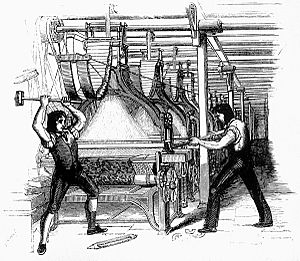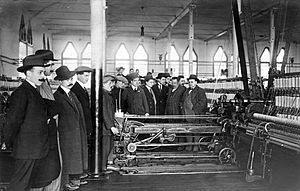Conflict of the selfactinas facts for kids

The Conflict of the Selfactinas was a series of protests in Barcelona, Spain, in July 1854. Workers were upset about new automatic spinning machines, called "selfactinas," because they believed these machines were taking their jobs. This conflict was a big deal because it led to the first general strike in Spain.
Contents
Why Workers Were Upset
New machines were changing how things were made, especially in textile factories. Sometimes, these changes caused problems for workers. In Spain, the first protests against machines happened in textile factories. This included places like Alcoy in 1821 and Barcelona in 1835.
By the 1840s, workers started forming groups called mutual associations. These groups helped workers support each other. They also used strikes as a way to demand better conditions.
Automatic spinning machines, known as "selfactinas," arrived in Catalonia around 1844. These machines could spin yarn much faster than people. By 1854, there were over 200,000 of these machine spindles in use. This meant fewer workers were needed, leading to more unemployment.
The Conflict Begins
In March and April 1854, many factory workers in Barcelona went on strike. They wanted to get rid of the "selfactinas" because these machines were causing people to lose their jobs.
Then, on June 30, 1854, there was an uprising near Madrid. This event, called the Vicalvarada, was against the government. On July 14, a similar revolt started in Barcelona. Workers joined in, restarting their strike. They not only wanted to ban the machines but also demanded political changes.
The very next day, several factories that used the new cotton-spinning machines were attacked. Some were even burned. On July 16, factories in Mataró also closed down. Workers there joined the protests, demanding the removal of the "selfactinas." About 60 factories were stopped by these strikes.
The military leader, Captain General de la Rocha, sent soldiers to protect the factories. He announced that anyone attacking property would be severely punished. The next day, three people were punished for setting factories on fire.
Trying to Find a Solution
Workers' representatives met with the Captain General. He agreed to issue an order on July 25. This order said that "selfactinas" should be replaced with older, less efficient machines. However, the factory owners refused to follow this order. They got support from the new Civil Governor, Madoz. So, the strike continued.
On August 8, a new Captain General, Domingo Dulce y Garay, met with the worker leaders. The workers presented a list of demands signed by nineteen different associations. They asked for forgiveness for the workers who had been punished and wanted the strike to end.
Within a week, Governor Madoz helped reach a deal between the factory owners and the spinners on August 15. The machines were not banned, but workers' wages were increased.
Even after this agreement, tension remained high. Workers continued to fight for higher wages and shorter working hours almost every day. On October 8, different worker associations met. They claimed to represent 80% of the city's workers, possibly between 40,000 and 80,000 people. They demanded a minimum salary for everyone.
More talks in November finally made the agreement with Madoz official. Spinners received an extra half-hour for their midday meal break. This meant their weekly working hours were reduced from 72 to 69 hours.
What Happened Next
The changes in the government in Madrid made the factory owners feel stronger. Tensions grew in early 1855, especially after the earlier order to replace machines was officially canceled. Strikes and "lock-outs" (when owners close factories to stop strikes) happened often.
After a controversial trial and the punishment of a worker leader named Josep Barceló Cassadó, the 1855 Catalan general strike began. This big strike led to an investigation in the Spanish parliament in November 1855.
The Conflict of the Selfactinas was very important. It showed that workers wanted their demands to be heard by the government. This conflict was the first time in Spain that people tried to make rules about child labor in factories. It also aimed to improve the working and social conditions for all workers.
See also
- List of strikes in Spain
- Origins of the labor movement in Spain
- History of the cotton industry in Catalonia
 In Spanish: Conflicto de las selfactinas para niños
In Spanish: Conflicto de las selfactinas para niños


